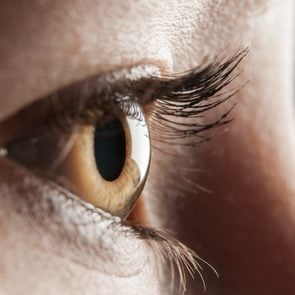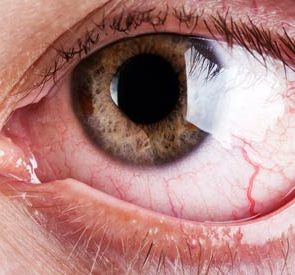10 Types of Vision Loss and What They Mean
Updated: Jun. 30, 2022
Cataracts, glaucoma, and macular degeneration are common causes of vision loss, but they're not the only ones. Learn more about the top 10 causes of vision loss.
What causes vision loss?
Your eyes are your windows to the world, and when they are up to task, you likely don’t give them a second thought.
Not everyone is that lucky.
As many as 12 million people aged 40 and older in the United States have some degree of vision impairment, including 1 million who are blind, according to the U.S. Centers for Disease Control and Prevention (CDC).
(Are you at risk? These are 11 signs your eyes could be in danger.)
There are many types of vision loss, some of which are preventable and/or treatable when caught early. Here’s what you need to know.
Cataracts
Marked by a cloudy area in the lens of your eye, cataracts are a common cause of vision loss, says Julia Haller, MD, ophthalmologist in chief of Wills Eye Hospital in Philadelphia.
“Everyone eventually gets cataracts as they get older,” she says.
Cataract symptoms may include blurry vision, sensitivity to light, trouble seeing at night, and/or double vision. Over time and left untreated, cataracts can lead to vision loss. Your eye doctor can diagnose cataracts through a dilated eye exam.
The good news? Surgery, which involves removing the clouded lens and replacing it with an artificial lens, is safe, and nine of 10 people who get it can see better afterward, according to the National Eye Institute.
Glaucoma
Another type of vision loss, glaucoma, can cause loss of side or peripheral vision, blind spots, and/or blindness. Glaucoma is caused by an increase in pressure inside your eye. Left untreated, it is one of the leading causes of blindness.
There are many different types of glaucoma, but the most common type is called open-angle glaucoma, the National Eye Institute points out.
“It’s hard to notice at first,” Dr. Haller explains. “People usually don’t realize they have glaucoma until it destroys more and more tissue, and they feel like they are looking down a tunnel,” she says. “You can have good central vision until the end.” This is why glaucoma screening is an important part of any eye exam.
There are medications and procedures that can help stop the damage, but glaucoma treatment won’t help you regain what was already lost, she says.
“Getting diagnosed early is the best way to preserve your vision,” she adds. Knowing your risks also helps you stay one step ahead of glaucoma.
Glaucoma risks include:
- family history
- advancing age, especially if you’re Hispanic/Latino
- African-American descent
There’s no cure for glaucoma yet, but there are treatments that can help save your vision. Prescription eye drop medications that reduce eye pressure are usually the first line of treatment for glaucoma. Laser therapy is also an option.

Age-related macular degeneration
Age-related macular degeneration (AMD) is the No. 1 cause of vision loss in people older than 50, Dr. Haller says. Located at the back of your eye, your macula is the part of the retina that lets you see details.
There are two main types of macular degeneration: dry and wet. These tend to cause central vision loss or the loss of the ability to see detail, leaving only peripheral or side vision intact.
Dry AMD is the most common form of the disease. It occurs when the macula gets thinner with advancing age and progresses gradually over several years.
There’s no treatment for late-stage dry AMD, but lifestyle changes and certain nutritional supplements can help reduce risk for this condition and prevent progression if it’s caught early. “Anything heart-healthy is retina-healthy,” Dr. Haller says.
The Age-Related Eye Disease Study (AREDS) and AREDS2 trials found that certain vitamins can slow the progression of intermediate to advanced AMD. AREDS2 supplements contain a mix of vision-friendly nutrients, including vitamin C, vitamin E, copper, zinc, lutein, and zeaxanthin.
(Check out these 5 recipes to avoid macular degeneration.)
Wet AMD is less common than the dry form, but it’s a lot more aggressive. “We do have pretty good treatments for wet AMD,” Dr. Haller says. A
nti-VEGF drugs block vascular endothelial growth factor (VEGF), which produces new blood vessels when your body needs them. With wet AMD, however, abnormal blood vessels can grow in your eye and cause vision loss.
Diabetic retinopathy
Rates of diabetic eye disease are skyrocketing due to the obesity epidemic, Dr. Haller says. This is the No. 1 cause of blindness in young people, but getting tighter control over blood sugar or glucose levels can stave off vision loss.
There aren’t necessarily any symptoms of diabetic retinopathy, which is why people are often caught off-guard. The good news? An annual routine eye exam could prevent 95 percent of vision loss caused by diabetes, according to the American Diabetes Association.
“People with diabetes should get yearly eye exams,” says Purnima Patel, MD, a clinical spokesperson at the American Academy of Ophthalmology and an assistant professor of ophthalmology at Emory University in Atlanta.
“The more severe the retinopathy, the higher the risk of decreased vision and sometimes permanent vision loss,” she says.
(These are the 17 best eating habits for people with diabetes.)
Refractive errors
Refractive errors are a leading cause of vision loss, Dr. Haller says.
There are several types of refractive errors, including myopia (nearsightedness), hyperopia (farsightedness), astigmatism (distorted vision at all distances), and presbyopia (loss of the ability to focus up close or read a menu among people age 40 and up). Most refractive errors can be corrected by eyeglasses, contact lenses, or surgery, she says.
(Need inspo? These 20 simple habits can improve your vision.)
Accidents
Any injury to your eye—such as a scratched cornea, sports-related accident, trauma, or chemical burn—can cause vision loss if it is not recognized and treated promptly. A scratched cornea can progress to vision-threatening keratitis or inflammation of the cornea if is not treated in a timely manner.
“If you get a scratch in your eye, see an eye doctor to make sure you don’t have what could turn into a devastating infection,” says Stephanie Marioneaux, MD, a clinical spokesperson for the American Academy of Ophthalmology and an assistant professor at the Eastern Virginia Medical School in Norfolk.
Migraines
There are many different types of migraines, and an ocular or eye migraine can cause sudden vision loss or blindness in one eye. This is usually temporary.
(Learn the migraine warning signs here.)
Tumors
There are times when vision loss can occur because of cancer or its treatment. Cancers linked to vision loss include:
- eye melanoma
- eye lymphoma
- cancer that spreads to the eye from another part of the body
- some head and neck cancers
- some brain cancers
Surgery and radiation therapy on or near the eye area can also cause vision loss, according to the Canadian Cancer Society. Your oncologist should discuss these risks with you as you plan your treatment.
Detached retina
A retinal detachment can occur when the light-sensitive layer of tissue in the back of your eye (the retina) breaks away from its normal position. When this happens, your retina is cut off from its oxygen and nutrient supply, leading to the death of the tissue and potentially permanent total or partial loss of vision in the affected eye, Dr. Haller says.
Treatment may involve use of a laser to reattach your retina, or the use of air or gas to push your retina back into place, Dr. Patel says. Sometimes surgery is needed if the retinal detachment is large enough, she adds.
Optic neuritis
Inflammation of the optic nerve (optic neuritis) can be a sign of multiple sclerosis (MS) and certain other diseases. The optic nerve carries images of what the eye sees to the brain, but when it is inflamed, it may cause sudden, reduced vision in the affected eye, according to U.S. National Library of Medicine.
This condition may go away on its own with no treatment. Sometimes steroids are needed to treat inflammation, but treating the underlying disease that is causing the optic neuritis is the best way to address optic neuritis.



















